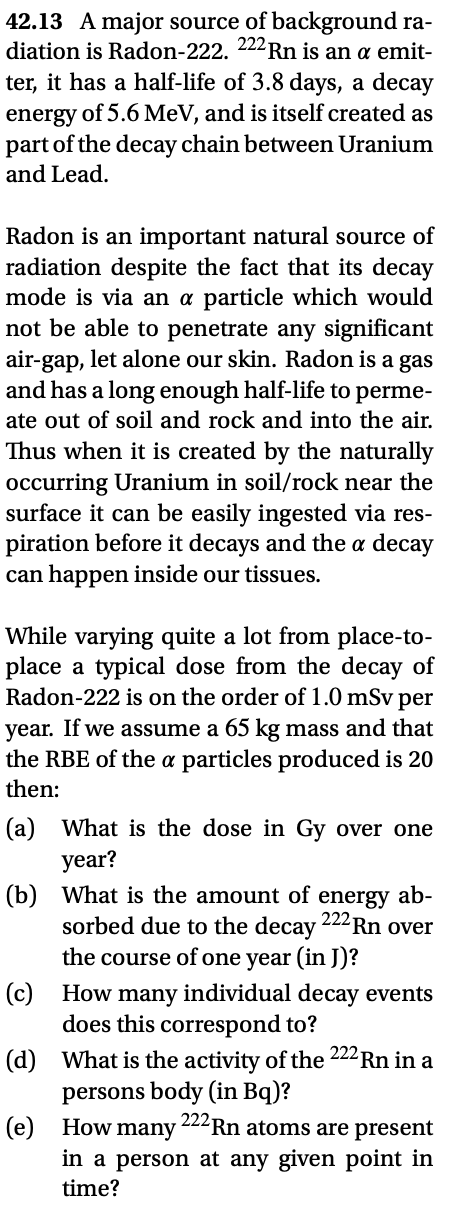Please answer the last three question (c, d and e). The answers are: (c) 3.63 × 10^9 events (d) 115 Bq (e) 54.5 × 10^6 atoms This is also not a graded assignment but just a practice problem for a final exam next week. All of the answers to the odd problems are in the book so I know these are the answers but do not know how to get them.
Please answer the last three question (c, d and e). The answers are: (c) 3.63 × 10^9 events (d) 115 Bq (e) 54.5 × 10^6 atoms This is also not a graded assignment but just a practice problem for a final exam next week. All of the answers to the odd problems are in the book so I know these are the answers but do not know how to get them.
Principles of Modern Chemistry
8th Edition
ISBN:9781305079113
Author:David W. Oxtoby, H. Pat Gillis, Laurie J. Butler
Publisher:David W. Oxtoby, H. Pat Gillis, Laurie J. Butler
Chapter19: Nuclear Chemistry
Section: Chapter Questions
Problem 23P
Related questions
Question
Please answer the last three question (c, d and e). The answers are:
(c) 3.63 × 10^9 events
(d) 115 Bq
(e) 54.5 × 10^6 atoms
This is also not a graded assignment but just a practice problem for a final exam next week. All of the answers to the odd problems are in the book so I know these are the answers but do not know how to get them.

Transcribed Image Text:42.13 A major source of background ra-
diation is Radon-222. 222Rn is an a emit-
ter, it has a half-life of 3.8 days, a decay
energy of 5.6MeV, and is itself created as
part of the decay chain between Uranium
and Lead.
Radon is an important natural source of
radiation despite the fact that its decay
mode is via an a particle which would
not be able to penetrate any significant
air-gap, let alone our skin. Radon is a gas
and has a long enough half-life to perme-
ate out of soil and rock and into the air.
Thus when it is created by the naturally
occurring Uranium in soil/rock near the
surface it can be easily ingested via res-
piration before it decays and the a decay
can happen inside our tissues.
While varying quite a lot from place-to-
place a typical dose from the decay of
Radon-222 is on the order of 1.0 mSv per
year. If we assume a 65 kg mass and that
the RBE of the a particles produced is 20
then:
(a) What is the dose in Gy over one
year?
(b) What is the amount of energy ab-
sorbed due to the decay 222Rn over
the course of one year (in J)?
(c) How many individual decay events
does this correspond to?
(d) What is the activity of the 222Rn in a
persons body (in Bq)?
(e) How many
in a person at any given point in
time?
222 Rn atoms are present
Expert Solution
This question has been solved!
Explore an expertly crafted, step-by-step solution for a thorough understanding of key concepts.
Step by step
Solved in 3 steps with 3 images

Knowledge Booster
Learn more about
Need a deep-dive on the concept behind this application? Look no further. Learn more about this topic, chemistry and related others by exploring similar questions and additional content below.Recommended textbooks for you

Principles of Modern Chemistry
Chemistry
ISBN:
9781305079113
Author:
David W. Oxtoby, H. Pat Gillis, Laurie J. Butler
Publisher:
Cengage Learning

Principles of Instrumental Analysis
Chemistry
ISBN:
9781305577213
Author:
Douglas A. Skoog, F. James Holler, Stanley R. Crouch
Publisher:
Cengage Learning

Chemistry & Chemical Reactivity
Chemistry
ISBN:
9781337399074
Author:
John C. Kotz, Paul M. Treichel, John Townsend, David Treichel
Publisher:
Cengage Learning

Principles of Modern Chemistry
Chemistry
ISBN:
9781305079113
Author:
David W. Oxtoby, H. Pat Gillis, Laurie J. Butler
Publisher:
Cengage Learning

Principles of Instrumental Analysis
Chemistry
ISBN:
9781305577213
Author:
Douglas A. Skoog, F. James Holler, Stanley R. Crouch
Publisher:
Cengage Learning

Chemistry & Chemical Reactivity
Chemistry
ISBN:
9781337399074
Author:
John C. Kotz, Paul M. Treichel, John Townsend, David Treichel
Publisher:
Cengage Learning

Chemistry & Chemical Reactivity
Chemistry
ISBN:
9781133949640
Author:
John C. Kotz, Paul M. Treichel, John Townsend, David Treichel
Publisher:
Cengage Learning

Chemistry: The Molecular Science
Chemistry
ISBN:
9781285199047
Author:
John W. Moore, Conrad L. Stanitski
Publisher:
Cengage Learning

Chemistry: Principles and Reactions
Chemistry
ISBN:
9781305079373
Author:
William L. Masterton, Cecile N. Hurley
Publisher:
Cengage Learning